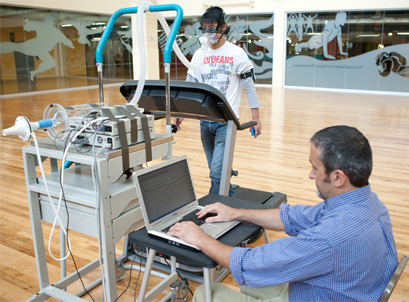
By Lisa Merkl
University Communication
What can’t the iPhone do? Now, thanks to a University of Houston computer science professor, it can even count how many calories you’ve burned in a given day.
A new, free download called Walk n’ Play is available from Apple’s “App Store” that allows users to have fun while burning calories. The game lets players keep track of their physical activity through their iPhones and already has 3,000 users to date.
Walk n’ Play was designed by a team of researchers from UH’s Computational Physiology Lab led by Ioannis Pavlidis, Eckhard Pfeiffer Professor of Computer Science and the lab’s director. Co-developers include post-doctoral researcher Pradeep Buddharaju and doctoral student Yuichi Fujiki.
Debuting in March and now released in an updated, improved version today, Walk n’ Play allows players to compete in real time against another iPhone user or against a simulator and watch the calories burn off as they go about their everyday walking.
“You just keep the phone attached to your waistband or carry in your pocket as you normally would, and it records every little motion you do – from walking to climbing stairs – and translates it into calories burned,” Pavlidis said. “The game operates on a 24-hour cycle and tallies everything up daily.”
While similar devices, such as pedometers, are nothing new, this iPhone application is unique in many respects. Pedometers, for example, communicate measures with such things as steps. Calories, however, are metabolic units and are the best measure of physical activity. For instance, a step taken by a 200-pound person is very different in terms of physical activity than a step taken by a 140-pound person. Boiling it down to simple mechanics, you need more energy to move a bigger mass.
The game also has an advantage over treadmills, which measure a user’s activity confined in space and time. Walk n’ Play allows using the world as a treadmill, Pavlidis said, typically giving a more accurate calorie count.
A defining characteristic of Walk n’ Play is the gaming or competition aspect. You are able to either employ the buddy system, commonly used in an exercise regimen, with a friend who also carries an iPhone or challenge yourself with a simulator that is programmed to follow an ideal routine for maintaining or losing weight through healthy activities. By trying to outdo your friend or follow the simulator’s behavior patterns, there’s a built-in incentive with this program. Pavlidis likens it to a form of social networking, motivating users to walk and putting them in contact with others.
“Modern conveniences have changed our way of life,” Pavlidis said. “The basic idea behind the application we’ve developed is for people to get motivated and back to living more active lifestyles.”
A modern person’s daily routine is sedentary. People used to climb stairs, wash clothes by hand, walk to work or the grocery store and often worked in manufacturing or farming jobs that required manual labor. These physical activities added up and have all but disappeared, along with the ability to expend anywhere between 1,000 to 2,000 calories per day, according to Pavlidis. We don’t sweat through everyday tasks like we used to.
Pavlidis hopes the Walk n’ Play application will encourage people to get into the habit of walking more during the day by perhaps taking a walk during breaks at work, parking in a spot that’s a little farther from the office, using the stairs instead of the elevator and developing a habit of walking after meals.
Real-time monitoring of physical activity and accurately measuring calories burned during movement is quite difficult, with the best way to do so being through a cardio-pulmonary instrument that determines the amount of oxygen consumed. This direct analog of one’s metabolic activity, however, would require a person to wear a gas mask wired to heavy equipment. In the lab, Pavlidis and his team found a way around this cumbersome set up, devising a method to correlate accelerometer values with virtual oxygen-consumption measurements to calibrate the iPhone to accurately measure calories burned.
Once Pavlidis’ group had a working prototype on the iPhone, they made it available for free download at Apple’s “App Store” in March. Just two months later, they have released a second version that is radically improved on many fronts. Most notably, it is now more user-friendly and the game recognizes more activity modes matched with appropriate animation to reflect walking and resting more realistically and accurately. |

